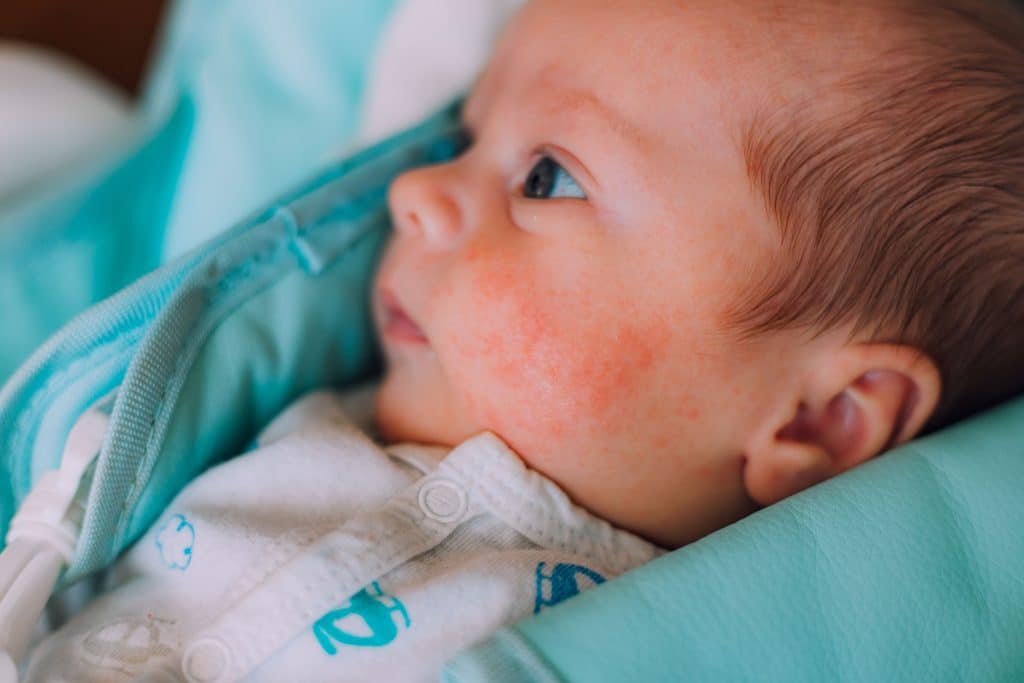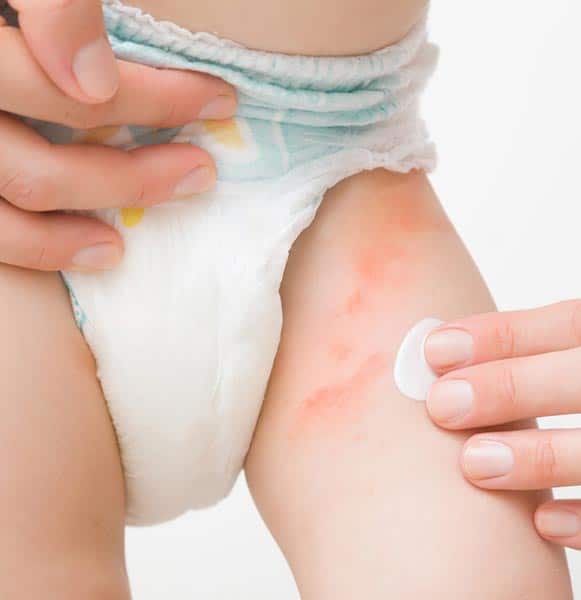Complete Guide to Infant Eczema
Complete Guide to Infant Eczema: Causes, Care, and Bragan Skincare’s Atopic Cream Solution
Fast answer: Infant eczema is a common skin condition that causes dry, itchy, red patches on a baby’s skin. Gentle bathing, fragrance-free moisturisers, and consistent daily care help soothe symptoms and protect delicate skin. If your baby is under 3 months old, symptoms are widespread, or if skin is weeping/crusting, speak with your GP or paediatrician.
Infant eczema, also known as atopic dermatitis, is a common skin condition affecting many babies. It causes red, itchy, and sometimes scaly patches on a baby’s delicate skin, leaving parents concerned and eager for relief. While infant eczema can be challenging to manage, understanding the condition and knowing how to treat it can make a huge difference. This guide will cover everything you need to know about infant eczema, from its causes and symptoms to the best ways to care for your baby’s sensitive skin. We’ll also introduce Bragan Skincare’s fragrance-free Atopic Cream, formulated with soothing snail mucin, as a gentle option for treating eczema.

What Is Infant Eczema and What Does It Look Like?
Infant eczema symptoms by age and location often show on the face, cheeks, and scalp, but they can spread to other areas, including the arms, legs, and torso. While it’s not contagious, it can be uncomfortable, making babies irritable or fussy, especially when they scratch at itchy skin.
If you’d like a quick medical overview of atopic eczema (including symptoms and typical treatments), the NHS guide to atopic eczema is a trusted place to start.
Symptoms of Infant Eczema
Recognising infant eczema can help parents seek the right treatment early. Here are the most common symptoms:
- Red or Pink Patches: The skin may develop reddish or pinkish patches, especially on the cheeks, arms, and legs.
- Dry, Scaly Skin: Babies with eczema often have very dry, rough skin that may feel bumpy or flaky to the touch.
- Itching: One of the main symptoms of eczema is itchiness, which can make your baby restless or irritable.
- Inflamed Skin: The affected areas may become swollen and warm to the touch.
- Thickened Skin: Over time, the skin may become thicker due to frequent scratching.
The symptoms can vary depending on the baby’s age, skin type, and severity of the eczema. Babies under six months typically develop patches on the face, scalp, and forehead, while older infants may have eczema on areas like the elbows, knees, and neck.
What Causes Infant Eczema?
The exact cause of infant eczema isn’t fully understood, but it’s believed to be due to a combination of genetic and environmental factors. Here are some common triggers:
- Genetics: Babies with a family history of eczema, asthma, or allergies are more likely to develop the condition.
- Skin Barrier Issues: Infants with eczema often have a weaker skin barrier, meaning their skin loses moisture quickly and becomes prone to dryness and irritation.
- Environmental Irritants: Common irritants like soaps, detergents, fragrances, and even saliva can trigger eczema flare-ups.
- Temperature Changes: Sudden changes in temperature or humidity can irritate a baby’s sensitive skin, leading to eczema.
- Allergens: Dust, pollen, pet dander, and certain foods can trigger allergic reactions, which can worsen eczema in some babies.
Understanding these triggers can help parents take preventive measures to minimise flare-ups.
How to Care for a Baby with Eczema
Caring for a baby with eczema requires gentle, consistent steps to soothe and protect their delicate skin. Here’s a routine to follow:
1. Bathing Tips
Bathing your baby is an essential part of managing eczema, but it’s important to do it carefully.
- Use Lukewarm Water: Hot water can strip the skin of its natural oils, making eczema worse. Stick to lukewarm water instead.
- Limit Bath Time: Keep baths short (5-10 minutes) to prevent the skin from drying out.
- Gentle Cleanser: Use a mild, fragrance-free baby cleanser to avoid further irritation.
- Pat Dry: After the bath, pat your baby’s skin dry with a soft towel rather than rubbing it.
2. Moisturise Right After Bathing
After bathing, it’s crucial to lock in moisture. Apply a gentle, fragrance-free moisturiser immediately after patting your baby’s skin dry. Moisturising regularly keeps the skin hydrated, reducing dryness and itching.
3. Avoid Fragrances and Irritants
Products with fragrances, alcohol, and harsh chemicals can aggravate eczema. Choose only fragrance-free and hypoallergenic products, including laundry detergents and baby wipes, to avoid unnecessary irritation.
4. Dress Your Baby in Soft, Breathable Fabrics
Clothing can make a big difference. Dress your baby in soft, breathable fabrics like cotton that won’t irritate the skin. Avoid wool or synthetic materials, as they can be scratchy and cause itching.
5. Keep Your Baby’s Nails Short
Babies can accidentally scratch their eczema patches, which can lead to infections. Keeping their nails short and covering their hands with soft mittens can prevent this.
6. Maintain a Cool Environment
Since heat can worsen eczema symptoms, keeping your home cool can help soothe your baby’s skin. Consider using a humidifier in winter to prevent the air from becoming too dry.
Choosing the Right Moisturiser for Infant Eczema
Selecting the right moisturiser is key to managing infant eczema. Look for these qualities:
- Fragrance-Free: Fragrance can irritate sensitive skin, so it’s best to choose a product without any added scents.
- Hypoallergenic: Hypoallergenic products reduce the risk of triggering an allergic reaction.
- Moisturising Ingredients: Ingredients like glycerin, hyaluronic acid, and snail mucin help hydrate and restore the skin’s moisture barrier.
- Anti-Inflammatory Properties: Some ingredients, such as chamomile and aloe vera, can help reduce inflammation and soothe irritation.
- Barrier Protection: Ingredients like ceramides and snail mucin strengthen the skin barrier, helping prevent moisture loss.

The Benefits of Snail Mucin for Infant Eczema
Snail mucin is an increasingly popular ingredient in skincare due to its hydrating and healing properties. It’s rich in hyaluronic acid, glycoproteins, and antioxidants, all of which help repair and protect the skin.
For babies with eczema, snail mucin offers several benefits:
- Deep Hydration: Snail mucin draws moisture to the skin, providing long-lasting hydration that helps relieve dryness and flakiness.
- Soothing and Calming: It contains anti-inflammatory properties that help reduce redness and irritation, which can make eczema patches less noticeable.
- Skin Barrier Support: Snail mucin strengthens the skin barrier, protecting it from external irritants and reducing the frequency of flare-ups.
Introducing Bragan Skincare’s Atopic Cream: A Gentle Solution for Infant Eczema
For parents looking for a safe, effective moisturiser for their baby’s eczema, Bragan Skincare’s fragrance-free Atopic Cream is an excellent choice. This gentle cream is specifically formulated for sensitive skin, offering all the benefits of snail mucin without any added fragrances or harsh ingredients.
Why Bragan Skincare’s Atopic Cream Stands Out
- Fragrance-Free Formula: With no added fragrances, this cream is gentle enough for the most sensitive skin, including babies with eczema.
- Soothing Hydration: Snail mucin provides deep, calming moisture that relieves dryness and itching, helping your baby feel more comfortable.
- Strengthens the Skin Barrier: By fortifying the skin’s natural barrier, this cream helps reduce the risk of future flare-ups and irritation.
- Non-Greasy, Fast Absorbing: This cream absorbs quickly, leaving the skin soft and smooth without a greasy residue.
Applying Bragan Skincare’s Atopic Cream after each bath can help manage your baby’s eczema, keeping their skin soft, calm, and well-hydrated.
Common Questions About Eczema in Babies
Can infant eczema go away on its own?
Yes, some babies outgrow eczema as they get older, especially if they receive consistent care. However, it’s important to manage symptoms effectively to keep the skin comfortable.
Is it safe to use snail mucin on babies?
Many people find snail mucin gentle and hydrating. As with any new skincare product for a baby, it’s best to patch-test first and stop use if you notice redness, stinging, or worsening irritation.
How often should I apply moisturiser to my baby’s eczema?
Moisturise at least twice daily, and always apply moisturiser right after bathing to lock in water. During flare-ups, you can apply more often to dry patches to reduce itching and tightness.
Can Bragan Skincare’s Atopic Cream be used on areas other than the face?
Yes. It can be used on areas affected by eczema such as the cheeks, arms, legs, and torso. Avoid use on broken or infected skin unless advised by a healthcare professional.
When should I see a doctor for my baby’s eczema?
Speak with your GP or paediatrician if eczema is not improving, is spreading quickly, your baby seems very distressed, or you notice signs of infection such as increasing redness, swelling, pain, crusting, weeping, or fever.
Long-Term Care for Infant Eczema
Managing infant eczema requires patience and a consistent skincare routine. Here are some long-term strategies to help keep your baby’s skin healthy:
- Stick to Fragrance-Free Products: From lotions to laundry detergents, choosing fragrance-free options reduces the risk of irritating your baby’s sensitive skin.
- Maintain a Consistent Routine: A simple, consistent routine helps prevent flare-ups and keeps the skin well-hydrated.
- Watch for Triggers: Over time, you may notice certain things that worsen your baby’s eczema, such as specific foods or fabrics. Avoiding these triggers can help keep symptoms under control.
- Stay in Touch with Your Doctor: Regular check-ups with your paediatrician or dermatologist ensure that you’re managing eczema effectively and adjusting care as needed.
Conclusion: Finding Relief with the Right Care and Products
Infant eczema can be challenging, but with the right care and the right products, you can manage your baby’s symptoms effectively. From gentle bathing practices to choosing a fragrance-free moisturiser, every step you take helps keep your baby’s skin healthy and comfortable.
Bragan Skincare’s Atopic Cream, with its soothing snail mucin formula, is a gentle, effective choice for moisturising and calming irritated skin. It’s designed to meet the needs of sensitive skin, offering relief without added fragrances or harsh ingredients. Incorporate it into your baby’s daily routine to experience the calming, hydrating benefits firsthand.
With patience, care, and the support of a trusted moisturiser, you can help your baby enjoy soft, healthy skin every day.
Additional Tips for Managing Infant Eczema Long-Term
While daily care is essential, there are several additional strategies to help manage infant eczema effectively over time. These small adjustments can make a big difference in keeping your baby’s skin comfortable and reducing flare-ups.
1. Monitor the Environment
Environmental factors like temperature and humidity play a big role in infant eczema. To maintain a balanced atmosphere:
- Use a Humidifier in Dry Weather: Dry air, especially in winter, can strip moisture from the skin, worsening eczema. A humidifier keeps the air in your home moist, helping to prevent the skin from drying out.
- Keep Your Home Cool: High temperatures can lead to sweating, which may irritate sensitive skin. Try to keep your home at a comfortable temperature to minimise sweating and heat rash.
2. Be Cautious with Laundry Products
Babies with eczema often react to common laundry detergents due to their harsh chemicals and added fragrances. Switching to a fragrance-free, hypoallergenic detergent can help reduce irritation.
- Double Rinse: After washing your baby’s clothes and bedding, do an extra rinse cycle to remove any lingering detergent residue.
- Avoid Fabric Softeners: Fabric softeners often contain fragrances and chemicals that can aggravate eczema. Opt for a gentle detergent and avoid softeners altogether.
3. Practice Safe Sun Exposure
While it’s essential to protect your baby’s skin from the sun, choosing the right sunscreen is important for babies with eczema. Look for mineral-based sunscreens that contain zinc oxide or titanium dioxide, as these are generally gentler on sensitive skin.
- Choose Sunscreens for Sensitive Skin: Avoid chemical sunscreens that may irritate the skin. Mineral sunscreens provide broad-spectrum protection without the harsh additives.
- Apply Sunscreen Only When Needed: For babies under six months, it’s best to keep them shaded rather than applying sunscreen directly to the skin unless recommended by a doctor.
4. Opt for Soft, Breathable Bedding
Your baby’s skin is in contact with their bedding for many hours each day, so choosing gentle, natural materials can help prevent irritation.
- Choose 100% Cotton Bedding: Cotton is soft, breathable, and less likely to irritate sensitive skin. Avoid synthetic fibres, which can trap heat and moisture.
- Wash Bedding Regularly: Regular washing helps reduce dust mites and allergens, which can trigger eczema in some babies. Use a gentle, fragrance-free detergent to avoid irritation.

Using Bragan Skincare’s Atopic Cream Consistently for Lasting Relief
Consistency is key when it comes to managing infant eczema. Bragan Skincare’s Atopic Cream is formulated with ingredients like snail mucin that provide both immediate relief and long-term benefits for sensitive skin. Here’s how to get the most out of this fragrance-free moisturiser:
- Apply After Every Bath: Moisturising immediately after bathing locks in moisture and helps protect the skin’s barrier.
- Use Twice Daily: Apply the cream in the morning and before bedtime to keep the skin hydrated throughout the day and night.
- Spot-Treat as Needed: During flare-ups, you can apply a small amount of Bragan Skincare’s Atopic Cream to specific areas needing extra care. Its calming, non-irritating formula makes it safe for multiple applications as needed.
The snail mucin in Bragan Skincare’s Atopic Cream hydrates, repairs, and strengthens the skin over time, making it a trusted choice for parents managing infant eczema. By using it consistently, you help build a stronger, healthier skin barrier for your baby.
When to Consult a Doctor for Infant Eczema
In many cases, gentle skincare and consistent moisturising can keep infant eczema under control. However, if you notice the following symptoms, it’s best to consult a paediatrician or dermatologist for further advice:
- Increased Redness or Swelling: If the affected areas become increasingly red, swollen, or painful to touch, it may indicate an infection.
- Cracked, Weeping Skin: Open sores or fluid discharge can be signs of severe eczema or a secondary infection that needs medical attention.
- Persistent Discomfort: If your baby seems constantly uncomfortable or fussy, even with regular care, a doctor can help assess the severity and provide additional treatment options.
- Lack of Improvement: If your baby’s eczema doesn’t improve with home treatments, a doctor may recommend other therapies, such as prescription creams or allergy testing.
Your paediatrician can provide guidance and additional resources, helping you manage your baby’s eczema more effectively.
If you’re unsure what you’re seeing, our guide to signs of eczema in infants can help you compare symptoms.
If you want to compare what you’re seeing at home with dermatologist guidance, the American Academy of Dermatology overview of atopic dermatitis explains common signs and what doctors look for.
Conclusion: Gentle Care and Consistency for Comfort
Managing infant eczema requires patience, consistency, and the right products. By adopting a gentle skincare routine and using a quality, fragrance-free moisturizer like Bragan Skincare’s Atopic Cream, you can keep your baby’s skin soft, comfortable, and protected. Daily care, including gentle baths, soft fabrics, and a controlled environment, helps reduce flare-ups and supports healthy skin.
Bragan Skincare’s Atopic Cream, with its unique snail mucin formula, offers deep hydration and soothing relief, making it a valuable addition to your baby’s skincare routine. Its fragrance-free, gentle composition makes it safe for daily use, helping your baby enjoy soft, nourished skin free from the discomfort of eczema.
Remember, while infant eczema can be challenging, a consistent approach with the right products will make a difference over time. With attentive care and Bragan Skincare’s support, you’re taking the right steps towards healthier, happier skin for your baby.
This article is for general information and does not replace medical advice. If you’re worried, contact your GP or paediatrician.
Featured Bragan Skincare Products
-
€32.51 – €81.30Price range: €32.51 through €81.30Select options This product has multiple variants. The options may be chosen on the product page
-
€81.30Select options This product has multiple variants. The options may be chosen on the product page
